By Lambert Strether of Corrente.
We’ve been reading a lot about shipping containers being “strewn about” Southern California because of congestion at the Port of Los Angeles, so I set out to learn a little bit more about them (not for housing purposes). As it turns out, shipping containers embody two subjects I really enjpy: Transportation, and international standards. (Most of the general knowledge in this post, such as it is, is taken from Marc Levinson, The Box: How the Shipping Container Made the World Smaller and the World Economy Bigger, a solid business history I bought a couple years ago and never got round to reading).
As transportation, container shipping is as global as it gets. Here is an image of the “CSC plate” (Convention for Safe Containers), which must be attached to every international shipping container:
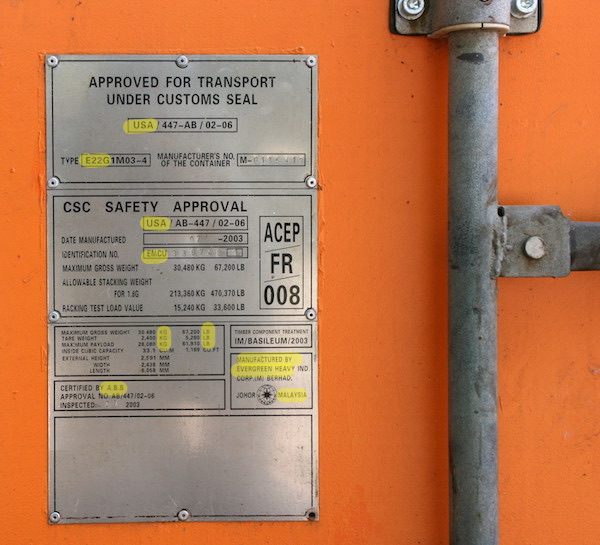
Among the political and commercial entities listed: E22G (ISO size type, I believe), USA (the United States of America), EMCU of Johor, Malaysia (Evergreen Marine Corporation, the manufacturer, a subsidiary of the famous Evergreen Group of Taiwan), A.B.S. (American Bureau of Shipping), and the realms of metric and Imperial/US customary measurement (“KG” and “LB” respectively). And much more I do not have time to decode.
As a product of standardization, container shipping is about as standard as it gets. That’s why a business in China can have the following image in their catalog:
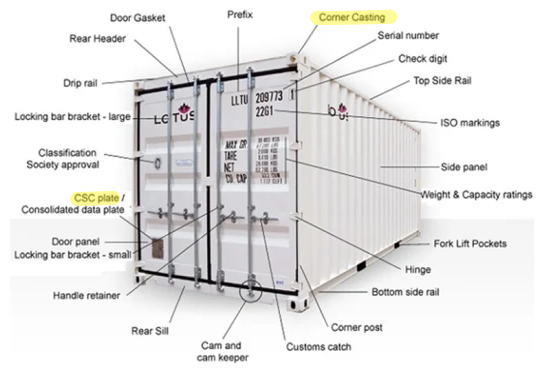
(I have highlighted the CSC plate, above, and the “corner casting,” which we will get to. Interchangeable parts, exactly as conceived by Eli Whitney, but manufactured and sold on a global basis.
Or maybe three subjects, besides transportation and standardization. As a child, I loved building with blocks, and the great thing about shipping containers, of course, is that they are stackable:
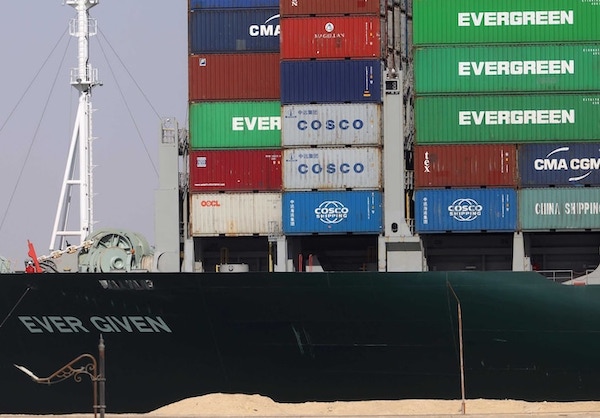
In this post, I’ll look at four topic areas that show the stackabilty of container boxes.
- Stackable Boxes
- Boxes in Standard Sizes
- Locks Connect the Boxes at Each Corner
- Ships Are Designed to Handle Big Stacks of Boxes.
Stackable Boxes
Here is a simple diagram of a container boxL

I have highlighted the vertical “corner posts” in yellow; they are the load-bearing elements, per the standard. The sides, the roof, and the bottom are not. I have also highlighted the “corner fittings”; these are used to connect boxes together through “locks” (see below), and also to lash them to each other and to the ship.
Of course, if the boxes were randomly sized, it might be fun for a child to stack them, but industrial stacking requires that the box dimensions (and fittings) be standardized.
Standardized Boxes
Standards development — after committee work worthy of the Bolsheviks, as we shall shortly see — for shipping containers began with the United States Marine Administration, was moved (or dragged) to ASA (the American Standards Organization, now ANSI, The American National Standards Institute), and then was moved (or dragged) to ISO, The International Organization for Standardization, where it resides today. The key ISO standard is ISO 668, “Series 1 Freight Containers — Classification, dimensions, and ratings.” which is eight pages long, not including the Annexes. Here is the standard’s scope:
This International Standard establishes a classification of series 1 freight containers based on external dimensions, and specifies the associated ratings, and, where appropriate, the minimum internal and door opening dimensions for certain types of containers.
Being an ISO standard, there are other standards it references normatively:
IS0 830, Freight containers – Terminology; IS0 1161, Series 1 freight containers – Corner fittings – Specification; IS0 1496-1, Series 1 freight containers – Specification and testing – Part I: General cargo containers for general purposes; IS0 1496-2, Series 1 freight containers – Specification and testing – Part 2: Thermal containers; IS0 6346, Freight containers – Coding, identification and marking.
Being an ISO standard, the text is a little dry, but to me it’s a thing of great beauty, because of the collective effort it enabled. Naturally, I expected the process of creating such beauty to be a virtual Platonic Symposium of engineering prowess and disinterested advocacy. Nothing could have been further from the truth. Here are several passages from Chapter 7 of Box, “Setting the Standard.”
On committee work:
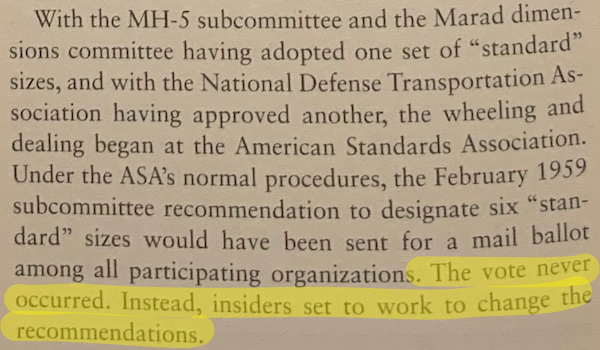
On engineering:
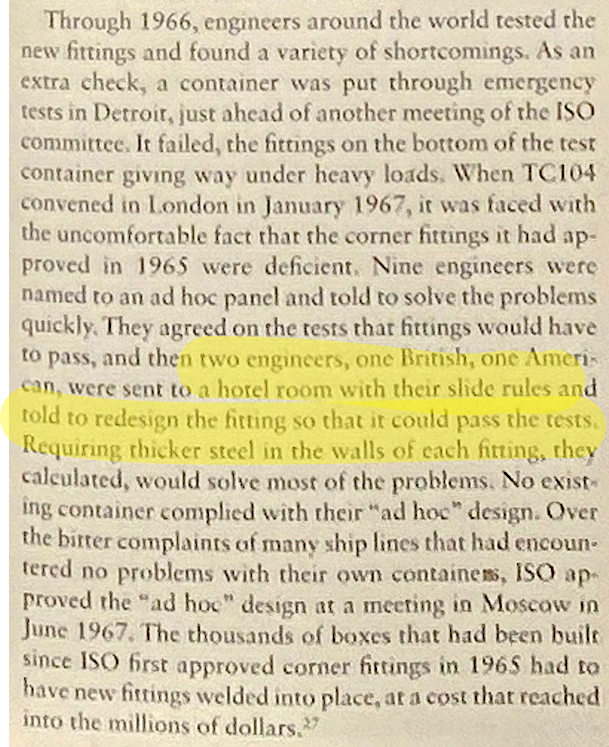
And yet, the ultimate result:
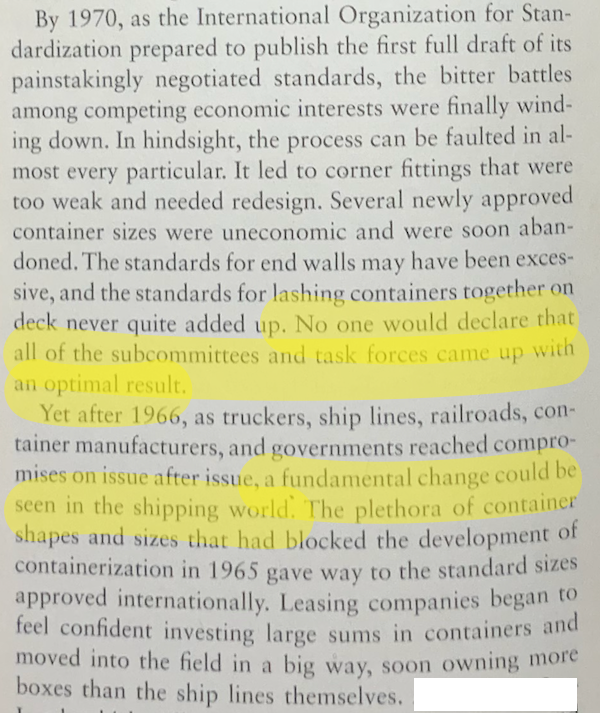
So now we have stackable boxes with standardized (“external”) dimensions. But what prevent the boxes in the stack from slipping out of position, turning a ginormous stack-bearing ship into a collapsing Jenga tower? The answer is that neighboring boxes can be locked together at their corner fittings. The corner fittings and the locks are also standardized.
Locks Connect the Boxes at Each Corner
The “corner fittings” are metal castings with holes in them, into which the locks (“twist locks”) can be inserted. (Ropes for lashing, or hooks for lifting by cranes, can also be inserted into them. Truck chassis also have corner fittings, to which the trucker locks the container.) From a manufacturer:
ISO1161 [naturally] corner castings are the big three-holed blocks of corten steel which form the corners of all ISO shipping containers. Cast from corten steel, usually in India or China and weighing 2.5 kg (5.5lb) they are the structural elements that are used to lift shipping containers as well as to connect them to whichever mode of transportation is being used to move the container such as ships, trains or road vehicles. They are also the connection point for shipping containers to be attached to each other, as in the case of stacks of containers aboard a container ship.
In order that all lifting and container transportation equipment works properly across the world, these corner casting have holes in them which have been standardised to a tolerance of mere millimetres. It is because of this standardisation, that no matter what you need to attach to your container, and no matter where in the world you are, Domino Clamps are guaranteed to be compatible with your ISO shipping container
(To a person like me, who puts the “stan” in standard, “Domino Clamps are guaranteed to be compatible with your ISO shipping container” should be accompanied by swelling music.)
Here is a manufacturer video that shows how corner fittings work:
(There is a whole world of container videos on YouTube. What’s interesting is that the comments that I saw were sober and well-informed, possibly because working with containers on ships, in port, or on trucks and rail is a skilled occupation with some risk to it.)
And here is how locks (“twist locks”) connect containers together at the corners. From Warsila:
A mechanical locking device at the corner of a container. Conventional twistlocks are locked and unlocked manually with operating rods. Rotating the movable part around a vertical axis locks the device and a container to a twistlock foundation on a hatch cover or another container. Reversing the motion effects unlocking. Semi-automatic twistlocks are locked automatically and unlocked manually by the operating rods. Fully-automatic locks are placed in the lower corners of the container at the pier. They lock automatically after the container is placed on the top, and unlock automatically when the container is lifted.
Here is a manufacturer video that shows how twist-locks work:
(Here is a link to a much grittier video, that shows a container ship and its containers as rusty and salt-encrusted.)
Ships Are Designed to Handle Big Stacks of Boxes
I didn’t really mean to wander into naval architecture, but I found this so fascinating I had to include it. In any case, we might as well know something about how the stacks of boxes travel over the sea to cool their propellers at the Port of Los Angeles. Here is some information on container ship design.
First, commercial considerations dictate speed. From Marine Insight:
Goods shipped in containers are often of high value, and high priority. For example, if a marine diesel engine for a ship being constructed in a shipyard in India is to be shipped in from Germany, the shipment would be made in a container, and is a high priority shipment because the installation of the engine into the engine room is a step in the construction process that would determine the possibility of delays in the later stages of construction. Also, the equipment needs to be delivered without any impact or damage. Thus, container ships are tightly time bound ships. They have a very low turnaround time, that is, the time they spend at a port for loading and unloading has to be minimum in order to be able to call the next port without delay. It is due to this reason, container ships fall in the category of high speed ships. In order to achieve a high speed, the resistance of the hull needs to be minimized, which is obtained by a fine form hull. In other words, container ship hulls have low coefficient of buoyancy, ranging from 0.6 to 0.7.
The Ever Given may have looked like a grotesquely fat tub, but it nipped along at 22.8 knots (26.2 miles per hour. A cruise ship travels at 20 knots; tankers lumber along at 12 or so). So, if I understand “fine form” correctly, a container ship should move through the water like a yacht, not a barge. However, in the middle of the ship, we have a big box to hold the stack of boxes:
Another notable geometrical characteristic of container ships is the high prismatic coefficient of the hull-form. That is, the hull section for most part of the length of the ship is almost rectangular. This is done in order to accommodate maximum number of containers below the deck.
And we need to make sure the big box (“torsion box”) doesn’t get twisted by the violence of the ocean:
Imagine the effect of cutting the strengthened rim off the paper cup. The same effect when extrapolated to that of a container ship, would result in devastating failures of the hull structure due to torsion. In order to prevent this, the topmost edges of the port and starboard sides of a container ships are strengthened with high scantling web sections, creating a box like structure at every frame. This is called torsion box. A torsion box runs along the entire length of the ship from the aft peak bulkhead to the forward collision bulkhead.
Conclusion
I hope this escapade was informative or at least fun. In reviewing the marvelous engineering and manufacturing that goes to make up the container revolution, I’m struck by a couple of things.
First, by the contrast of container shipping to the operations of the Port of Los Angeles: What’s holding matters up seems to be fees, rents (and profit). Nothing to do with containers, ships, trains, trucks, cranes, or anything material. One is almost tempted to imagine that the forces of production and the relations of production are somehow in conflict.
Second, by the contrast to software engineering. Why is it that a fantastic system for distributing commodities in a standardized way developed for goods, but never for data or code?


Let’s not forget DoD’s contribution to containerized freight, the CONEX box! They’ve been using these things since the Korean War to transport freight from the good ole’ US of A to the far flung reaches of The Empire and everywhere in between.
https://en.wikipedia.org/wiki/Conex_box
> the CONEX box
This too is in Box. I assume the system was never adopted commercially because the dimensions were wrong (plus they stacked three high). Also, the boxes were heavy; “More than three quarters were shipped only once, because they remained in theatre. The CONEX boxes were as useful to the soldiers as their contents, in particular as storage facilities where there were no other options.”
The picture on the wiki page to compare the two different sizes is some sort of comedy
As to your last question; I hypothesize that failures in a physical shipping regime are blatant and obvious, while failures in code and software are often subtle enough to go unremarked by the “average” observer, and can this metastasize ‘in secret’ as it were.
When a shipping container fails, ‘things’ get strewn about in a huge mess. When code fails, it can present as a ‘glitch,’ the seriousness of which does not become apparant until later. The physical detritus of a shipping container failure must be cleaned up quickly. Actual ‘things’ get in the way of ‘normal’ physical function and thus demand a quick remedy. Not so with many ‘failures of code.’ Many of the cascades of failure attendant to code fails are almost secret until ‘real’ world consequences begin to become noticeable.
A second possibility as to why the two classes of failure are treated differently lies in the nature of the two processes and the attendant classes of worker involved.
Actual shipping is a fairly straightforward process. The people involved have little to no “mystique” attached to their tasks. For some arcane reason, code workers inhabit a class of work imbued with an aura of ‘magic’ and ‘glamour.’ I’m reminded of a daily newspaper comic strip where the technology repairperson was portrayed as a Traditional Wizard, complete with ‘Magic Wand” and star encrusted pointy hat. This sort of ‘in group’ has a vested interest in minimizing the failures of other members of the Secret Fraternity.
Anyway, that’s my story and I’m sticking to it.
No mention of the “father of container shipping,” Malcom McLean? Fascinating how in the turbulent 1960s, one man set out on a crusade…to ship things in giant boxes instead of crates.
Biggest surprise reading this: the specification was approved at an ISO meeting in Moscow!
I never would have imagined the Soviet Union would be involved in any way with the story of container shipping.
Thank you for this.
Box is very good on McLean. But this isn’t a history of the container industry. I didn’t mention Keith Tantlinger either, who invented and patented the twist lock, them made it royalty free.
Malcolm McLean, whose shipping company Sea-Land built the fastest cargo ships evah! These 55k ton bad boys do 33 knots across the waves which is FAST for something that big.
https://en.wikipedia.org/wiki/Algol-class_vehicle_cargo_ship
The Algols soldier on to this very day transporting imperial war vehicles nowadays instead of containers.
FWIW, my father sold Malcolm McLean his first 2 “container ” ships after a failed busines in MAriel Cuba (ahem).
While said shipping containers may or may not be the optimal dimension for shipping, it really only takes a group of contract lawyers, greedy CEOs and PMC executives to truly screw things up for everyone ;)
Case in point, EV battery form factors. Had there been the same universal demand for consistency and bureaus of standards to insure adherence, we could drive into a refuel station with our EVs and swap out a battery in less time than it takes to fill-er-up the old school way.
I’ve read that a used one can be had for $4000. Perhaps before the coming social collapse I’ll buy some mountain property and have one delivered. A fixer upper.
The shipping construction standards probably don’t guarantee bulletproof-ness but should ward off modest sized battering rams.
> A fixer upper
See the link in the first paragraphs; using containers for housing (a la the first pages of Snow Crash is not a good idea. Which is too bad, because their modularity — and maybe their colorfulness? — makes that seem so appealing.
They are already being used for housing in Copenhagen that also draws on another great Danish invention, Lego
https://www.urbanrigger.com/
I worked at the Port Department of the Port Authority of New York and New Jersey 1984-1990, when New York was still the biggest container port in the United States, maybe the world (but losing market share fast). Malcolm McClean’s last big effort was a fleet of so called “Econ” ships, made after the energy crisis of 1973, big 4500 TEU ships, then enormous but still narrow enough to transit the Panama Canal, and his company offered round the world service – each ship took 60-70 days to circle the world (I think) and there were a bunch of them, all in the same “string” so each port visited had a visit from this company’s ships every week or two. The ships were slow for fuel efficiency, only 12 knots, ie this was directly opposite the speedy greyhounds that had been built before. The venture did not work out as just in time deliveries became the rage and those ships ended up tied up on New York’s west side by the Passenger Ship terminal for a long time and eventually sold for virtually nothing for scrap I think. I saw McClean one day, he came in for a meeting, a big tall old man, really tall, looked very unhealthy, and I think he died not long thereafter. This was early 1985 I think. He is called the father of this industry, and rightfully so, but there is a big “but” to this, reflected in an earlier comment. A man named Tom Leatham, a Port Authority worker who in 1984 had worked for 35 years there without taking a single sick day (seriously) told me that the concept of a “box-ship” ie using a truck body box carrying cargo to be shipped between ports, was first used by the military between the West Coast and Alaska, using I think 20 foot boxes which fit the military chassis. I am guessing McClean got his idea from that, which had been in place since just after World War 2. Lambert’s summary here is terrific. What seems lost in many articles about all this is that McClean’s vision worked for the US, where the truck body box and chassis was pretty standard. I think the first such ship went from New York to Texas in 1956, the truck boxes lashed to the deck. It wasn’t until the late 60s or even the early 70s that specially built container ships built to handle only containers were launched – that is, set up to stack containers from the bottom of the hold to the main deck, then covered by a big hatch, then more containers stacked on top of that hatch. Initially containerization was a pretty US-centric thing, because in England and Europe and Asia trucks and chassis were all different, but once the 40 footer was standardized then it took off all over the world.
One other point – the twist locks work to fasten containers atop each other on a ship, but a huge part of preparing a ship for sailing is “lashing” which is done by longshoremen when loading the containers and then checked by the ship’s deck crew once underway. Lashing refers to these 12 to 20 foot long one inch diameter rods, with turnbuckles threaded at each end with shackles, which are fastened to the corners of containers and then placed on the ships walkways between stacks of containers, and tightened using big rods turning the tunrbuckle, such that these long rods are drawn as tight as possible to attach the stacks of containers not only to each other but to the ship, too. Between each stack of containers on a ship is a space, about 6-7 feet wide (?) which yu can see when a ship crosses in front of you and you see it side-on, and in that space, rising three or four levels about the main deck, is a gantry platform, with a level at each container level, and railings, accessed by ladders at each end of the gantry (ie at each side of the ship) and this is the thing those lashings are fastened to, and tightened from. It is hard work, but essential because if the weather gets bad those stacks will move and sway, and, unless held down, will come loose, and often they come loose anyway if the weather is really bad. When I sailed we ran the east coast of the US (New York, Charleston, Savannah, Norfolk and then we crossed the Atlantic through the Straits of Gibraltar to the Suez Canal on our way to Singapore) and when we left Norfolk we’d turn to to check all the lashings and make sure they were tight. This took two or three days, actually. Then we’d check everything again before we reached Gibraltar, and it was astounding how much those lashings would go slack because of the ship’s motion. I don’t know if you can call this work highly skilled, but it is hard physically and tough to do properly, and that gear is heavy and dangerous. If a section of one of those lashings, say if the turnbuckle and shackle are unthreaded from the rod, that turnbuckle section and shackle alone weighs 30 pounds, and if it drops or falls and your hand is in the way youl’d lose your hand. I almost lost mine, three times.
Thank you for this! This kind of stuff should be known…Lots of physical work and danger to make commerce look effortless and seamless!
> a huge part of preparing a ship for sailing is “lashing”
Thanks for this great information. I limited my scope to stacking (though I grant a stack that was slipping and sliding around in the hold could sink the ship).
What I noticed and thought was awesome, was that the corner fittings were also used for lashing. Just great, great technology.
> I don’t know if you can call this work highly skilled, but it is hard physically and tough to do properly, and that gear is heavy and dangerous.
I certainly would call it highly skilled, for the reasons you just gave; the “grittier” video I linked to gives some idea of the weight and the danger. We think of plenty of people who perform physical feats as highly skilled; I don’t see why we would think that for circus acrobats or professional actors, and not sailors on container ships.
There’s a film about containers and the system to which they belong: The Forgotten Space.
Fantastic writeup, Lambert, thanks.
This was very similar to the story of the original B-52 bomber design in 1948 (from Wikipedia):
Maybe hotel rooms are conducive to excellent thinking? Or maybe people just worked better and faster in the days before computers?
I think it’s probably more to do with getting competent people in different areas together in an unconstrained project. It’s not often managers (or colonels, or finance) get out of the way of the product experts. Most design exercises are so bound by preset targets that they can’t innovate regardless of who is involved. Even more have lots of organisers and operators and very few if any experts involved.
> Fantastic writeup, Lambert, thanks.
[lambert blushes modestly]
Or things were less complicated. Both technically and organizationally. Especially since this was an iterative design on the B-47, so no huge technical risks, especially one that required software.
Organizationally, the customer, in this case, Colonel Warden, appears to have the background and experience to communicate effectively of what is needed (i.e. good requirements) while not being too specific to over constrain the engineers. The story seems to imply he was directly communicating with the top engineers, without layers of contracts, finance, and other management.
Maybe that small aspect of the design was hammered out in few days, but the overall system evolved over a long time, iteratively, and with real world feedback.
This reminds me of how standards in computer/electrical/telecom world are done. Examples include the IETF and the Internet standards, and 3GPP for mobile telecom (3G WCDMA, 4G LTE).
I know a few guys working 3GPP standards. An alphabet soup of NGOs and government agencies from professional societies, standards associations, national regulators to the United Nations are involved. It’s a grind of working groups, conferences, and meetings. These are held all over the world, and attended by subject matter experts – many who have been doing it for decades. Standards are maybe the last bastion of systematic and long term thinking that exists in our neoliberal capitalist system.
Well done, Lambert.
I think it could be argued that the packet is the standardised unit of code and software exchange that you’re looking for. This here www is pretty neat in its own way.
Thanks for the post, the twist lock explanations and videos cleared up something that had been a mystery to me for a long time (why don’t containers fall down more).
> why don’t containers fall down more
Don’t forget the lashing!
More on Naval Architecture
The hull of a container ship has another interesting feature and that is the “bow bulb”. That thing low in the water at the front of the ship. It is a calculated size to improve the movement of the ship through the water at cruising speed (20 knots). It is said to reduce fuel consumption by up to 12%.
So these ships are designed to be big AND fast. See:https://www.marineinsight.com/naval-architecture/why-do-ships-have-bulbous-bow/
Lambert, this is a wonderful explanation! I’m actually involved in the field (two patents in the works that will be filed around the New Year). Yours is the best short summary I’ve found and the pictures and videos were the right ones. Plus all the comments were on the money and extended what you said.
I’ll just add a few short comments.
The corner posts each must supports 1/4 of a 72,000 lbs load plus wracking and the “bounce” as a box lands on a wave. And they are stacked, originally seven-high and now 11-high, so the bottom posts now carry up to 220,000 lbs each… and that’s just the dead load.
The containers were part of the revolution but the twist-lock was the missing piece of the puzzle that made “today” happen.
The containers needed to fit on US trailer-trucks. Thus the 8 foot width and the original 40 foot length. Today an interstate truck can be 72 feet long so boxes 53 feet long with seven foot overhangs and the corner posts 40 foot apart in the center are the new standard. They also fit into the standard rail car limits cradled between the wheels stacked 2 high on the mainlines of the Santa Fe, etc. I’ve seen the ruts in the Roman stone roads. The track width was a Roman chariot’s width. The container dimensions are the new chariot wheels and the ships and trucks are the Roman roads. At least one corner of the American empire may last a 1,000 years… along with the foot and the inch. Take that, you Metric bastards!
Finally the cross-lashings (a big “X” of cables securing an array of boxes on shipboard) along with the very rigid twist-lock/box scheme creates a huge torsion box inside the ship; the ship torsion system just keeps the ship rigid enough when the ship is empty to take the boxes with no slop. Today most container ships have vertical rails that hold arrays of boxes like clips of ammunition. The two rigidities, that of the ship and that of the box array, complement each-other
For the fun of it look up “Container ship accidents” on YouTube to see what can go wrong. Then you’ll understand how strong the twist-locks and the corner posts are.
Anyway. Great work.
> The container dimensions are the new chariot wheels and the ships and trucks are the Roman roads. At least one corner of the American empire may last a 1,000 years… along with the foot and the inch. Take that, you Metric bastards!
Great parallel, thanks!
My understanding is that the width of a chariot was in turn determined by the width of two horses side-by-side, which makes sense, so that ultimately all of these dimensions depend on the width of a horse’s ass.
This includes by the way the size of the space shuttle, and perhaps other space vehicles and/or launchers, since they must travel from where they’re built to the launch pad on a railway with a tunnel.
All hail equine haunches!
Thanks for this great article, Lambert. If there is one thing I like it is elegant solutions and this is such the case here. Containers on trucks heading to a port where they are swapped for other containers straight off a ship. Standards that are the same all across the planet with interchangeable parts down to millimeters. Elegant, just elegant. Of course there must have been a desire on some people’s part to set the standard that they would have a patent for it but the logic of this idea swept such concerns behind. If only we could do the same with things like EV charges being made standard across the planet or being able to play things like DVDs anywhere in the world. Standards make for the win.
2.5kg = 5.5-lb
Fixed, thanks!
“Why don’t they fall down more?” Well, as my co.(s) stressed during marine insurance sales training, large stacks on container ships fall down, with many being crushed or swept overboard, all the time. Try searching ‘container ship fail’ for lots of fun photos and videos. Remember, you REALLY want your containers to be in the ship’s hold ; )
I’ve read the Box, but also laud Marc Levinson’s history of the rise of the modern supermarket: Levinson, Marc. 2012. The Great A & P and the Struggle for Small Business in America. New York; Godalming: Hill and Wang . I read it while working on a short history of retailing in Japan, which originated in my experience with mom-and-pop-store lined shopping streets and with the question of why Walmart failed in Japan.
Anyway, I’ve been in a shipping port, watching from below as containers were loading. That too is backed by systems, including software that handles containers in waiting (in the port I visited, stacked 7 high because, without corner locks, anything higher was unstable in a strong wind), and then governs the sequence by which they are unstacked and loaded.
My hunch, from long years around factories, is that such systems are robust to modest deviations from normal, but collapse into chaos when things get seriously out of whack. COVID shutdowns plus a huge uptick in volume would do exactly that. Containers end up outside the yard, and then congestion further delays getting them in place below the loading cranes. Empty containers end up taking space intended for incoming containers, and vice-versa, adding to delays in loading and unloading and getting containers on their way to distribution centers. A COVID shutdown at one of those centers would back up the flow, too, potentially all the way back to the port. And the volumes kept rising.
Although the mechanics of containerization are interesting, the information management of these units seems to be a Gordian Knot that needs to be cut by convergence on a new model for efficient cycling of container traffic through ports. A clean-sheet design of a fully automated container port, incorporating robotic cranes and self-driving trucks would provide an organizing perspective for taking steps toward rationalizing the current mess. Even at a distance, it is obvious that there is something seriously wrong with the dispatching of trucks to collect containers. For trucks to be waiting for hours before they can be loaded means that there is an obvious optimization problem concealed by uncooperative players in the port system. A Federal task force should be created and empowered to develop and mandate new practices for the management of container cargo in US ports.
As for software, we currently use IETF, IEEE, and Bluetooth standards for inter-networking. JSON and XML for data exchange. For other things in software: RESTful APIs for web. POSIX for applications.
There’s so many standards, and so many layers of them. Then there’s all the legacy stuff.
My work experience includes system and software engineering in DoD (Navy). Reusable code was a holy grail. The idea of standard libraries and modular design were a big thing. DoD created Ada programming language to push more standardization in source code. Then came object-oriented paradigm and that killed Ada before it really took hold. DoD (and telcom and aviation) had rigorous development methodologies. I retired before “agile” became the thing. I’m not sure how agile works with standardization. (My work included working in flight and ordnance, including nuclear, safety, so was a bit more conservative than your typical system engineering effort.) In ordnance safety, zero reliance was placed on software.
Python I guess currently is the top language, and there’s no shortage of modules available to incorporate into projects, but there’s no standardization on APIs so each module becomes its own problem to understand.
The Navy under Grace Hopper put software understanding and development on steroids. COBOL alone would have deserved a prize.